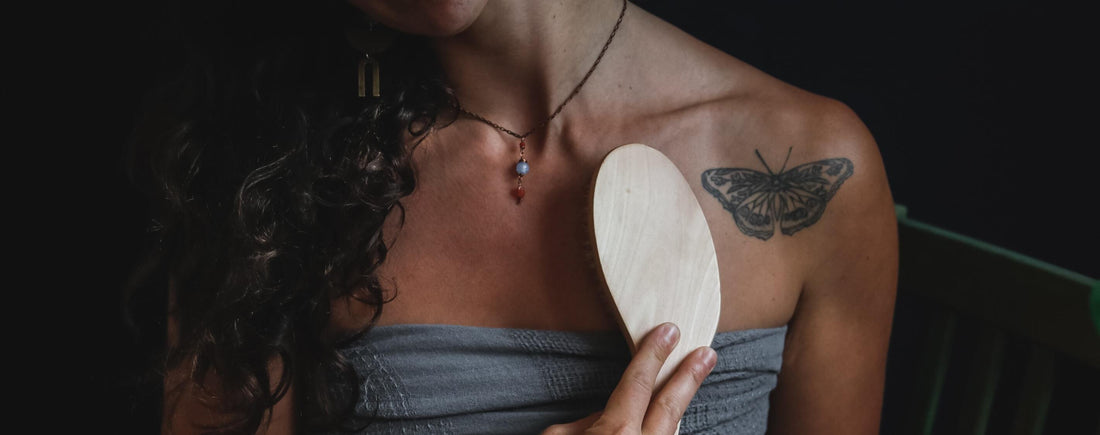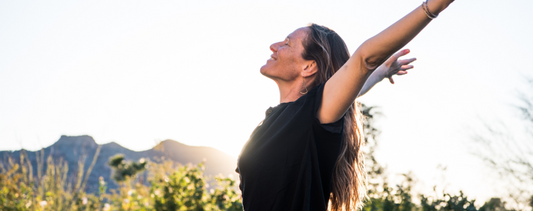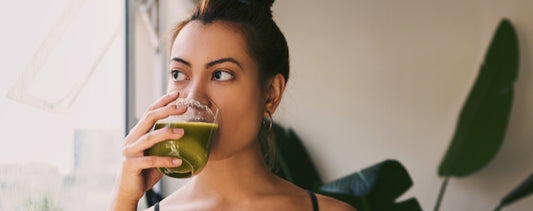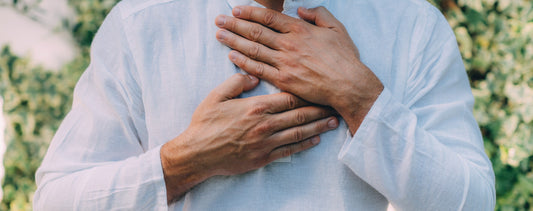Tune up your immune system for cold and flu season. Good nutrition, proper rest, and regular exercise are the basics of staying healthy. However, you can pump up your resistance even more by adding self-massage to your daily or weekly routine.
Massage promotes relaxation and increases circulation. It also triggers measurable changes in the body’s immune and endocrine systems. One 2019 study, by a The Massage Centre, concluded that a single session massage can significantly increase production of white blood cells, which are vital to the body’s ability to fight illness.
But not all of us can afford the luxury of regular sessions with a trained therapist. Fortunately, self-massage such as dry brushing, acupressure, and Abhyanga can be just as effective. Do your body and mind a favor by practicing one or all of these three easy techniques.
You’ll need a soft, natural-bristled brush or, for gentler exfoliation, cotton or silk gloves. Proceed with gentle, repetitive strokes, upward from the feet and hands, and always toward the heart to encourage lymph drainage. Use long strokes on the long bones of the legs and arms, and on the back. Use circular strokes on the joints, chest, and belly. Do not use too much pressure, and be careful on sensitive areas—your skin should turn just slightly pink.
A dry brushing session should take between 5 to 15 minutes, depending on the demands of your schedule. Do it before your morning shower, so you can rinse away any loosened skin cells and toxins.
A baby-bottle warmer works well to heat oil in pump or squeeze bottles, while a mug warmer is perfect for ceramic or metal cups. Abhyanga is a rhythmic friction massage. Use long repetitive strokes on long bones—always toward the heart— and circular strokes on joints, abdomen, chest, and face. Don’t forget your head and feet.
Don’t be in a rush to take that oil off your skin. It’s a good idea to rest for 5 to 15 minutes afterward, to give the oil time to penetrate. Sit in a sauna or steam room, if you have access. Surface oil can then be gently buffed off with a soft, dry towel. If you need to be less greasy, a warm shower with mild soap is recommended. Abhyanga is more time consuming than dry brushing, but well worth treating yourself to once or twice a week. Visit Ayurvedic Healing for an Abhyanga consultation.
In traditional Chinese medicine, the Kidney 27 points are considered strong immune boosters—they are the final points on the kidney meridians of the body, which are the energy channels that govern the strength of our constitution. Located immediately below the collarbone, about an inch from the midline on each side, they are easy to access when you’re working at your desk or heading home for the holidays in a crowded plane. You can use steady or circular pressure, or even tap to activate these points. Watch this video for a good demonstration.
Marma therapy is the Ayurvedic version of acupressure. In Marma, the tala hridaya point is found on the sole of the foot and the palm of the hand. This point is connected to the lungs and respiratory function, and is a great point to stimulate for immunity. To find it on the hand, reach down to the palm with your middle finger, pressing in just above the mound of muscle that is below the thumb (thenar eminence). On the foot, it can be found on the upper portion of the mid-sole of the foot, directly in line with the middle toe. Gentle, slow, circular stimulation is all that is needed to activate these points and help you breathe easier.
*Editor’s Note: The information in this article is intended for your educational use only and is not a substitute for professional medical advice, diagnosis, or treatment. Always seek the advice of your physician or other qualified health providers with any questions you may have regarding a medical condition and before undertaking any diet, supplement, fitness, or other health programs.
Experience the bliss of self-abhyanga massage with our limited release of the Chopra Body Oils. Shop now to enhance your practice and revitalize your mind, body, and spirit.
Massage promotes relaxation and increases circulation. It also triggers measurable changes in the body’s immune and endocrine systems. One 2019 study, by a The Massage Centre, concluded that a single session massage can significantly increase production of white blood cells, which are vital to the body’s ability to fight illness.
But not all of us can afford the luxury of regular sessions with a trained therapist. Fortunately, self-massage such as dry brushing, acupressure, and Abhyanga can be just as effective. Do your body and mind a favor by practicing one or all of these three easy techniques.
1. Dry Brushing
Your skin is a first line of defense from disease. It acts as a barrier, supports detoxification, and synthesizes Vitamin D, an important element of immunity. If the skin’s integrity is compromised or its surface is clogged with dead cells, it can’t do its job properly. Dry brushing, known as Garshana in Ayurvedic medicine, exfoliates the skin, helps release impurities by encouraging blood and lymph flow, and, like any massage, helps reduce stress.You’ll need a soft, natural-bristled brush or, for gentler exfoliation, cotton or silk gloves. Proceed with gentle, repetitive strokes, upward from the feet and hands, and always toward the heart to encourage lymph drainage. Use long strokes on the long bones of the legs and arms, and on the back. Use circular strokes on the joints, chest, and belly. Do not use too much pressure, and be careful on sensitive areas—your skin should turn just slightly pink.
A dry brushing session should take between 5 to 15 minutes, depending on the demands of your schedule. Do it before your morning shower, so you can rinse away any loosened skin cells and toxins.
2. Abhyanga Self-Massage
Abhyanga is an Ayurvedic massage technique using warm dosha-specific oils (learn about doshas here). It increases circulation, encourages lymph flow, supports detoxification, reduces stress, and promotes sound sleep. Almond, coconut, safflower, sesame, grapeseed and jojoba are all great oils for Abhyanga and can be used alone or in combination. If you add immunity-boosting essential oils, it becomes an even more potent treatment.A baby-bottle warmer works well to heat oil in pump or squeeze bottles, while a mug warmer is perfect for ceramic or metal cups. Abhyanga is a rhythmic friction massage. Use long repetitive strokes on long bones—always toward the heart— and circular strokes on joints, abdomen, chest, and face. Don’t forget your head and feet.
Don’t be in a rush to take that oil off your skin. It’s a good idea to rest for 5 to 15 minutes afterward, to give the oil time to penetrate. Sit in a sauna or steam room, if you have access. Surface oil can then be gently buffed off with a soft, dry towel. If you need to be less greasy, a warm shower with mild soap is recommended. Abhyanga is more time consuming than dry brushing, but well worth treating yourself to once or twice a week. Visit Ayurvedic Healing for an Abhyanga consultation.
3. Acupressure
Acupressure is closely related to acupuncture. Consisting of gentle pressure at specific spots along the energy channels of the body, it can improve energy flow, diminish pain, and restore equilibrium by releasing subtle blockages. Stimulating these points at regular intervals during the day is an easy way to shore up your defenses.In traditional Chinese medicine, the Kidney 27 points are considered strong immune boosters—they are the final points on the kidney meridians of the body, which are the energy channels that govern the strength of our constitution. Located immediately below the collarbone, about an inch from the midline on each side, they are easy to access when you’re working at your desk or heading home for the holidays in a crowded plane. You can use steady or circular pressure, or even tap to activate these points. Watch this video for a good demonstration.
Marma therapy is the Ayurvedic version of acupressure. In Marma, the tala hridaya point is found on the sole of the foot and the palm of the hand. This point is connected to the lungs and respiratory function, and is a great point to stimulate for immunity. To find it on the hand, reach down to the palm with your middle finger, pressing in just above the mound of muscle that is below the thumb (thenar eminence). On the foot, it can be found on the upper portion of the mid-sole of the foot, directly in line with the middle toe. Gentle, slow, circular stimulation is all that is needed to activate these points and help you breathe easier.
*Editor’s Note: The information in this article is intended for your educational use only and is not a substitute for professional medical advice, diagnosis, or treatment. Always seek the advice of your physician or other qualified health providers with any questions you may have regarding a medical condition and before undertaking any diet, supplement, fitness, or other health programs.
Experience the bliss of self-abhyanga massage with our limited release of the Chopra Body Oils. Shop now to enhance your practice and revitalize your mind, body, and spirit.






















